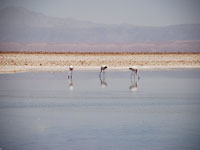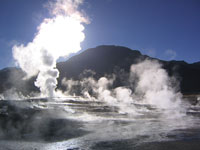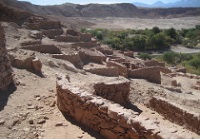Things to do in San Pedro de Atacama
San Pedro de Atacama is not famous for its sightseeing opportunities but rather because it is situated in the midst of an adventurer's paradise of deserts, mountains, lagoons and salt pans.
Travellers typically use the village as a home base while exploring the astounding surrounding landscapes. Which is not to say the town is not worthy of mention; it just pales in comparison to its surroundings. Sandboarding, hiking, horse riding and mountain biking are all commonly enjoyed activities in the area. And once travellers are stiff and exhausted from all their thrilling outdoor escapades, there is nothing better than visiting the Puritama Hot Springs to soak it all away in the naturally hot water, or sitting in one of the shady alcoves of a bar on the main plaza with an ice-cold cocktail in hand.
One unmissable attraction in San Pedro de Atacama is Pukara de Quitor. These ancient, pre-Incan ruins are less than an hour's walk from the centre of town and, although the fortifications are not as impressive in scale as some of the mammoth ruins of South America, the views from the site are spectacular. Also close to the town are the El Tatio Geysers and the opportunity to experience this unique, steamy environment should not be passed up. In addition, there are a number of lagoons high up on the plateau which never fail to delight visitors.
The Reserva Nacional Los Flamencos is said to be the most popular nature reserve in Chile, which is really saying something in a country that boasts so many truly breathtaking wilderness areas. The Valley of the Moon, a surreal salt lake landscape, is one of the most popular destinations within the park and can actually be reached comfortably by bike from San Pedro for those who would prefer to avoid the crowded tours. It is a huge reserve with many areas worth exploring for the beautiful desert scenery and interesting flora and fauna.

Reserva Nacional Los Flamencos
This popular nature reserve in northern Chile (many claim it is the most popular) is 459 square miles (740km sq) and is divided into seven sections, all offering highlights of thei…
Reserva Nacional Los Flamencos
This popular nature reserve in northern Chile (many claim it is the most popular) is 459 square miles (740km sq) and is divided into seven sections, all offering highlights of their own. One of the most interesting areas within the Reserva Nacional Los Flamencos is the Valle de la Luna (Valley of the Moon), a surreal landscape of salt peaks formed by uplifted lake sediments that have been shaped into dramatic formations by wind erosion. The valley's unearthly blend of pastel colours makes it even more enchanting at sunset. Close to San Pedro de Atacama, the valley can be reached by mountain bike or on a guided tour.
A striking feature of northern Chile's geography is the shimmering and apparently endless salt lakes, home to many bird species. The Salar de Atacama (Salt Flat of Atacama) in the reserve has a lagoon, Laguna Chaxa, which supports three species of flamingos as well as other bird life.
The salt lake also affords good views of the volcanoes in the Andean chain of mountains on the nearby altiplano (high plain). The stunning desert landscape offers many attractions: hiking, horse riding, bird watching and photography among them. Visitors should be aware that, in this desert region, temperatures vary dramatically and can drop suddenly.

El Tatio Geysers
At an altitude of 13,760 feet (4,300m) El Tatio is one of the world's highest and hottest geyser fields, and is surrounded by volcanoes and fed by 80 geysers and hundreds of gassy …
El Tatio Geysers
At an altitude of 13,760 feet (4,300m) El Tatio is one of the world's highest and hottest geyser fields, and is surrounded by volcanoes and fed by 80 geysers and hundreds of gassy fumaroles. The geyser fields are best viewed at sunrise when there are changes in atmospheric pressure; the steaming fumaroles are particularly spectacular at this time, shooting clouds of steam about 35 feet (112m) into the air.
While it is possible to bathe in the hot geyser water in a small pool, parts of the field are highly dangerous, with only a thin crust over nearly boiling mud, so it is always a good idea to visit the geysers with a knowledgeable guide.
It's a glorious attraction for photographers as the steam and the odd landscape make for dramatic scenes. The geysers are not advisable for anybody who has respiratory issues, though, so visitors with breathing problems should proceed with caution. Visitors should also be sure to wear layers as it is much warmer at the geysers, even though the pre-dawn temperatures are freezing.
Most travellers visit the geysers as part of a guided tour. These usually leave San Pedro de Atacama early in the morning. Many operators offer this trip and it is worth shopping around to find the best option. A number of geyser tours include a stop at nearby hot springs in the desert, which is a great addition.

Pukara de Quitor Ruins
The Pukara de Quitor Ruins are a short distance from the town and one of the most popular attractions in San Pedro de Atacama. The fortifications were built by the pre-Incan Atacam…
Pukara de Quitor Ruins
The Pukara de Quitor Ruins are a short distance from the town and one of the most popular attractions in San Pedro de Atacama. The fortifications were built by the pre-Incan Atacameno civilisation in the 12th century. The ruins have not been excavated fully, despite being incredibly well preserved, as they will be quickly destroyed by the elements if they are exposed further.
The way they stand, half-uncovered, actually adds to the mystique of the place, and visitors can still have a fair idea of what the structures would have looked like originally. To help travellers envisage the buildings as they once were, a replica of one of the 800-year-old houses has been built.
A bike ride or a quick hike to the ruins is one of the most popular things to do in San Pedro de Atacama. The distance is under three miles (4km) and can be walked in about an hour. The path is well sign-posted and not demanding. Possibly the most astounding part about the fort are the views from the site, and even those visitors who have seen more extensive and impressive ruins, such as those just north in Peru, will still be blown away by the vistas. The ruins can be explored with remarkable freedom, which is also a bonus.



